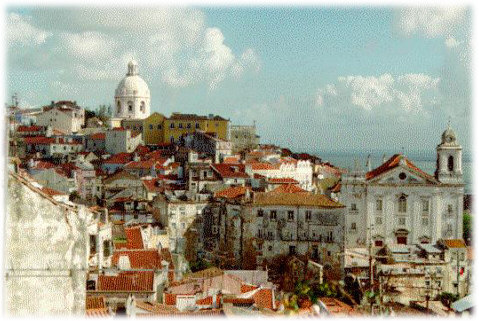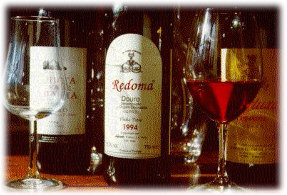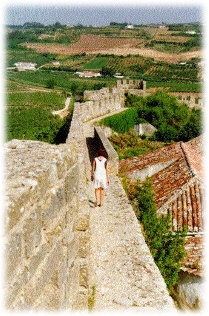

A view over the rooftops of Lisbon
Spotlight on Portuguese wines
"In a world of increased standardization, Portugal shines like a beacon of
individuality and independence"
Oz Clarke, Oz Clarke’s Wine Atlas.
[Note added September 2002: this piece is now horribly out of date, and reflects in large part my limited understanding of Portuguese wines back in December 1999. But I've left it here for the sake of historical interest. Jamie Goode]
Wine writers seem always to be in search of ‘The Next Big Thing’ in the world of wine, and for several years now many have dubbed Portugal as exactly this. I think for a number of reasons Portuguese table wines (as opposed to the already well established Port wines) are poised to fulfill their so far largely latent potential on the world stage. Giving a run through of my recent exploration of a selection of what Portugal has to offer, I’ll explain why.
You need to think about Portuguese wines: they are certainly not
obvious. They demand, and will repay, application and perseverance. As expressed in the
quote above, the great appeal of Portuguese wines lies in the fact that Portugal has
stubbornly refused to take the 'Cabernet and Chardonnay plus new oak' fast track; it has
also largely ignored
the appeal of the rising star of Syrah, which would seem so well suited to many of its
terroirs. Instead, shunning in large part the desire to adopt the consumer-friendly
practice of varietally labelled wines, Portuguese producers have stuck by their many
indigenous grape varieties that are virtually unknown elsewhere and have carried on doing
what they always have, perhaps with a bit of modernization in the winery.
Portuguese red
wines offer an exciting journey of exploration for inquisitive wine geeks whose palates
have become jaded by alcoholic, overoaked and over-everything blockbuster reds that seem
to dominate retailers' shelves and clear out gold medals at the wine competitions.
Portuguese wines probably won't be the ones that will impress at big, crowded tastings;
instead, I suspect they are more likely to satisfy when contemplated over for the course
of a quite evening meal with good friends.
ignored
the appeal of the rising star of Syrah, which would seem so well suited to many of its
terroirs. Instead, shunning in large part the desire to adopt the consumer-friendly
practice of varietally labelled wines, Portuguese producers have stuck by their many
indigenous grape varieties that are virtually unknown elsewhere and have carried on doing
what they always have, perhaps with a bit of modernization in the winery.
Portuguese red
wines offer an exciting journey of exploration for inquisitive wine geeks whose palates
have become jaded by alcoholic, overoaked and over-everything blockbuster reds that seem
to dominate retailers' shelves and clear out gold medals at the wine competitions.
Portuguese wines probably won't be the ones that will impress at big, crowded tastings;
instead, I suspect they are more likely to satisfy when contemplated over for the course
of a quite evening meal with good friends.
 The view from the delightful walled town of Obidos |
What
the critics say:Its
very unpredictability and refusal to conform to international norms are what makes
Portugal such a gloriously fascinating wine country and yet such an infuriating one. Oz Clarke, Oz Clarke’s wine atlas The Portuguese have had this strange habit of making wines to
suit the palates of other Portuguese rather than making the sort of fruity,
juicy-yet-structured wines that appeal to the majority of the world’s wine consumers. If the sheer variety of Portugal’s landscape and grapes is
allowed space to shine, the prospect is (sic) exhilarating. |
Over the last few months, I have been exploring some of the Portuguese wines available in the UK. Most merchants stock just a few Portuguese wines; I'm not aware of any real specialists (although if you are out there and I've missed you, I'd be delighted to know). The vast majority of these wines are red; this broadly reflects the relative abundance of reds over whites on retailer's shelves. Following are the tasting notes of the wines that I have tried, broken down by region. After each tasting note, details of the supplier, price and date of tasting are given.
Douro
Redoma 1994, Douro
This Douro red from Niepoort is made from Tinta Amarela, Touriga Francesa and Tinta Roriz
vines with an average age of 55 years. It was bottled unfiltered in July 1997. An opaque
purple/black, this has a powerful nose of cherries and olives, with some garrigue-like
herbal notes, some chocolate and some coffee. On the palate it is concentrated, with firm,
dry tannins. This is a massive wine! Huge and savoury, dark and brooding, with bitter
cherries and herbs coming to the fore, the oak it has seen is virtually undetectable.
Imagine a bone dry, young port. Sensational stuff, distinctly Portuguese, and one of the
most memorable wines I have had in recent months. One for ageing. (£13 Bentalls) 10/99
Quinta do Vale D. Maria 1996 Douro DOC, Portugal
Another heavyweight red from the Douro valley, made by Christiano van Zeller, formerly of
Quinta do Noval. Concentrated deep red/purple colour. Full nose of herbs, coffee and
spice. The palate is dry, tannic and with good acidity, with hints of tobacco and cedar.
This is not a wine with instant appeal, but it is substantial and authentic: if you give
it the attention and thought it deserves, it will reward you. No doubt this will improve
with some bottle age. Good. (£9.49 Oddbins Fine Wine) 11/99
Duas Quintas Douro 1996, Ramos Pinto
A blend of Tinta Roriz and Touriga Nacional. The palate is dominated by berry
fruits with a touch of pepper. Firm tannins, good concentration and nice balance, without
noticeable oak. This is a good table wine, but nothing special. It is not noticeably
Portuguese. Apparently the Reserva is something special, but it is considerably more
expensive. (£6.75 Bentalls) 9/99
Quinta do Crasto Reserva 1996, Douro
Another in the line of Portuguese wines that I have recently been exploring. This
is a blend of old vine varietals that has spent 9 months in French and American oak.
Purple black with a concentrated nose of bitter cherries and a hint of olives. Immediately
after opening it is a little reserved, with a palate dominated by tart bitter cherry
fruit. The high acid and bitter fruit, coupled with the firm tannic structure make it hard
to sip casually (i.e. without food), but after about half an hour the wine begins to open
out beautifully, revealing a pleasant herbiness/gaminess, and complex spicy fruit
character. Quite a complex package, and one that will reward some cellaring. The oak is
not really noticeable. Very good. (£7.99, Fullers) 11/99
Quinta do Crasto 1997, Douro
A blend of 50% Tinto Roriz, 25% Tinta Barocca, 15% Touriga Nacional and 10%
Touriga Francesca. Red/purple in colour, this juicy herb and cherry-laced red has enough
spicy complexity (perhaps from the partial new American oak treatment) to maintain
interest. Rich and medium bodied, soft and ripe, there is a smoky edge to the berry fruit,
and a touch of chocolate. Pretty good, but I recommend paying the extra £2 for the
Reserva. (£5.99, Fullers) 1/00
Alentejo
Cartuxa, Evora 1995 VQPRD, Fundacao Eugenio de
Almeida
Medium red colour. Inviting, perfumed nose of cherries and spice, with some gamey
aromas mixed in. On the palate, mouthfilling flavours of ripe cherry fruit, with an
amazing soft, silky texture and real complexity. There is some brett, too, with medicinal
and herbal notes in the background. This wine avoids the rathe bitter character I've often
encountered in Portuguese reds. There is real concentration and class here, with all the
elements in harmony. Fantastic wine; distinctly Portuguese, quite unusual, but of stunning
quality. It is made from a blend of Periquita, Aragonez, Trincadeira, Moreto and
Alfrocheiro. I'd really recommend you try this if you can find it. It changed my opinion
of Portuguese wine. (Bentalls £10.50) 2/99 (Tasted twice subsequently with consistent
notes.)
Aragonêz 1996, Herdade de Esporão, Alentejo
Another sturdy Portuguese red, this time a varietal from the large Alentejo firm
of Esporão. I tasted this alongside the Quinta do Crasto Reserva 1996 (see note above).
Both wines are the same colour, a dense purple black, but immediately this wine stood out
because of a blast of sweet new American oak. On the palate there is a strong cherry
component, high acidity, and spicy vanillin oak. However, it would be unfair to say that
it is overoaked, as the oak balances well with the spicy, bitter fruit, making a well
rounded package. However, I'm not as enthusiastic about this wine as I am the Quinta de
Crasto, which gains complexity in the glass, whereas this wine wears all its allure up
front. Good, but not 'authentic'. (£6.99, Fullers) 11/99
Esporão Reserva 1995, Reguengos DOC, Alentejo,
Portugal
Deep red/purple. Rich red berry fruit combined with considerable new oak, and
backed up with firm tannins. Moderately high acidity, giving the wine quite a firm, tight
structure. This is in an international, modern style, with good concentration and
complexity but ultimately not particularly Portuguese. Good, but not what I was after.
(Tesco £7.99) (2/99)
Esporão Reserva 1990, Reguengos DOC, Alentejo,
Portugal
Brick red fading to brown at the rim. After some years in bottle, this has
softened out and now shows gently spicy strawberry fruit and an enticing cedary nose. It
is drinking nicely, but I suspect it does owe a lot of its character to the oak in which
it was aged, rather than the fruit. (Thresher £6.99) (7/99)
Esporão Branco Reserva 1997, Reguengos DOC,
Alentejo, Portugal
Nose of lemny fruit with a distinctive 'boiled sweets' components (known as 'hard
candy' in the USA I believe). On the palate, fresh, crisp lemony fruit with complexity
from new American oak. After a while the wine opens out a little to reveal nutty and waxy
components. It is quite a useful food wine with its crisp acidity and deep flavours, but
there seems to be a bit of a hole in the mid palate, and for my tastes this wine is rather
too technologically made. Good, but not outstanding. (£6.99 Oddbins) 12/99
Tinto da Anfora 1994, Vinho Regional Alentejano, JP
Vinhos
A blend of grape varieties aged for 1 year in small barrels of Portuguese oak and
chestnut. Nice, lifted fragrant nose of sweet herbs, cherries and earthy woodiness. On the
palate there are reasonably firm tannins and complex flavours of mushrooms, black
cherries, olives and coffee. Distinctively Portuguese. Medium bodied and very good.
(£5.99 Sainsbury) 12/99
Dao
Quinta das Maias 1996 Dao
Red purple colour. Leafy, herby nose is followed up on the palate by soft red
fruit (cherries) and moderate tannic structure, some of which is no doubt contributed by a
touch of new oak. Hints of spice, olives and coffee contribute to what is a fairly
complex, burgundy-style wine that is nicely put together. I like it. (Bentalls, £7.15)
(7/99)
Dão Dom Ferraz 1997
Touriga Nacional/ Jaen. Deep purple red. Distinctive nose of smoky, herby
cherries. On the palate this is soft and rounded, with an attractive herbiness, more
cherries and a touch of blackcurrant and chocolate. There must be some oak in there too.
Very nice wine: modern, but still authentic, and quite like a new wave Southern French red
in character. A bargain, too. (£4.99 Tesco, Thresher) 10/99
Dom Ferraz 1996 Dao Reserva
Light ruby in colour, this has a muted nose of herbs and wet stones. There is
soft, ripe cherry fruit, moderate acidity, no oak and a medium concentration. A little
plonkish, but for the price this is well made. Again, lots of similarity with low end
burgundy.(Thresher, £2.99) (7/99)
Bairrada
Dom Ferraz Bairrada DOC 1997
Made mainly from the Baga grape. This is a cherry red colour, with a fruity nose
of cherries, strawberries and vegetation. This initially seems to be a rather simple fruit
driven wine, but develops to reveal a pleasant herbiness and a touch of spicy oak. Good
concentration. It is not a great wine, but for this price it is a good bargain: modern
styled and clean. (£4.89 Tesco) 11/99
Other regions
Quinta de Abrigada Tinto 1996, Alenquer, VQPRD
Made from Periquita and Alicante Bouschet, this wine comes from a region just
north of Lisbon, a little inland. Nose is muted with some wet stones. On palate there are
plums, cherries and some pepper spice, but the new oak claimed on the back label is not
immediately evident. Reasonably complex and harmonious, with dry tannins, this is good but
not a bargain. OK. (Bentalls £6.99) (2/99)
Moscatel de Sétubal 1988, Adega Cooperativa de
Palmela
Deep brown/orange, with distinctive sweet grapey fruit, nicely matched with
Tawny-like wooding and rich honey and nut overtones. Very unusual, I prefer to serve this
chilled as an aperitif than to use it as a dessert wine. (Bentalls £8.50) (6/99)
Palha-Canas 1997, Vino Regional Estremadura,
Companhia des Vinhas de S. Domingos
Dense purple-black with a slightly port-like nose. Soft black cherry fruit
without any harsh edges, and a touch of chocolate. Distinctively Portuguese, and very
good. (Bentalls £6.99) (5/99)
Quinta da Lagoalva 1994, Ribatejo, Portugal
Red purple. Porty, smoky nose. Bitter cherry and damson fruit with strong tannins
and high acid. A touch of oak gives some spice-like character. It is nicely balanced, but
still distinctively Portuguese. (£5.99 Oddbins) (4/99)
Alianca Palmela VQPRD 1994, Portugal
Made from Periquita this has a herby, port-like nose. Slightly tart with black
cherry flavours. The pleasant bitterness gives it good food compatibility, but there is
little worth dwelling on here. (£4.99 Oddbins) (3/99)
Bela Fonte Baga, Beiras, 1998
Attractive red/purple colour. Bright and fruity with deep cherry fruit combined
with spicy and medicinal notes, and some herbiness which I associate with the Baga grape.
There are hints of American oak. Overall, this is quite modern styled but still retains
more than a hint of authenticity. Very good for the price. (£4.99 Tesco) 11/99